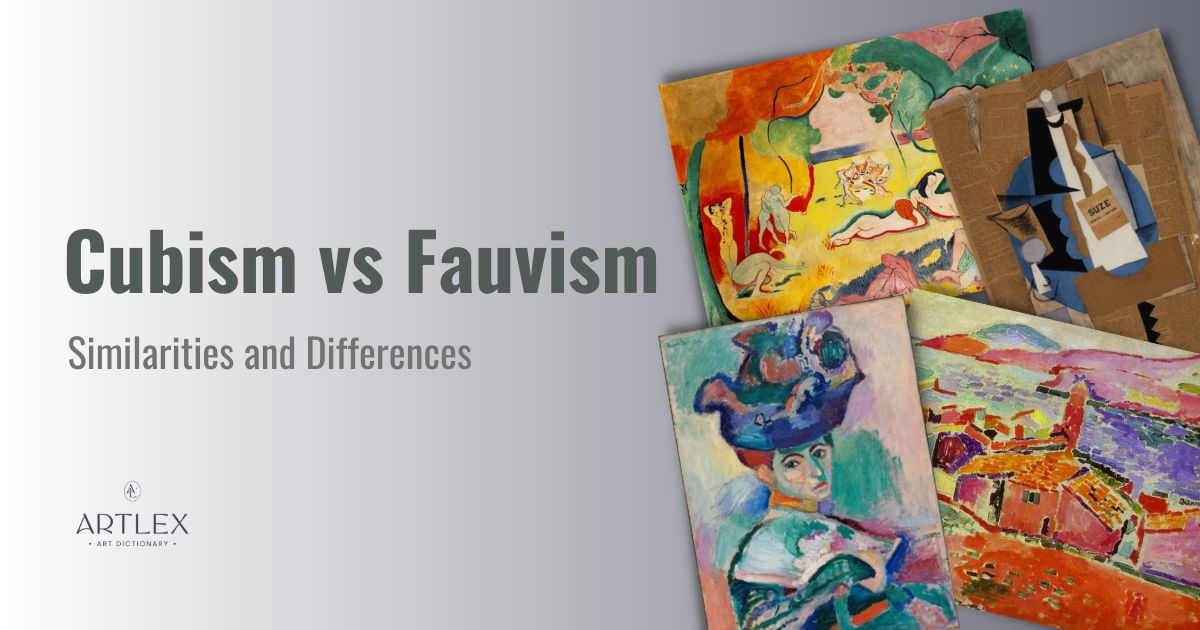
Fauvism is an art movement that emerged in France around 1905 and dissolved around 1908. Fauvism rejects Impressionism’s soft, pastel color palette and is characterized by bold, contrasting colors and wild, textured brushstrokes. Fauvist paintings are figurative, meaning that the subject is recognizable, but many lean towards abstraction. French painter Henri Matisse was the leader of the Fauvist movement.
Cubism originated in France and was active between 1907 and 1914. Cubist artwork features a fragmented composition representing the subject from all angles through multiple overlapping geometric planes. Artists Pablo Picasso and Georges Braque experimented with form and composition to propel Cubism through its phases: Proto-Cubism, Analytical Cubism, and Synthetic Cubism.
Cubism and Fauvism have many similarities and differences. The three main similarities between Cubism and Fauvism are textured brushwork, flat appearance, and finding inspiration in Post-Impressionism.
The three main differences between Fauvism and Cubism are the Fauves’ use of unnatural color, their simplified subject matter, and lighthearted themes.
Cubism and Fauvism Similarities
Cubism and Fauvism have many similarities, including the artists that practiced within each distinct style. The three main similarities between Cubism and Fauvism are textured brushwork, flat appearance, and finding inspiration in Post-Impressionism.
Cubism vs. Fauvism: Textured Brushwork
Cubist and Fauvist artists applied paint using loose, textured, constructive, and segmented brushstrokes to distance themselves from literal or illusionistic representation conventions.
Cubist and Fauvist artists could achieve more visually and conceptually complex compositions by painting with loose brushstrokes. Cubists reassembled their previously disassembled subjects using short, sketch-like brushstrokes to build up color and value in opaque layers. For Fauvists, textured brushstrokes also conveyed a sense of spontaneity, especially when paired with saturated and complementary colors.
Henri Matisse’s View of Coillure, pictured below, is a colorful landscape made up of loose, textured brushstrokes:
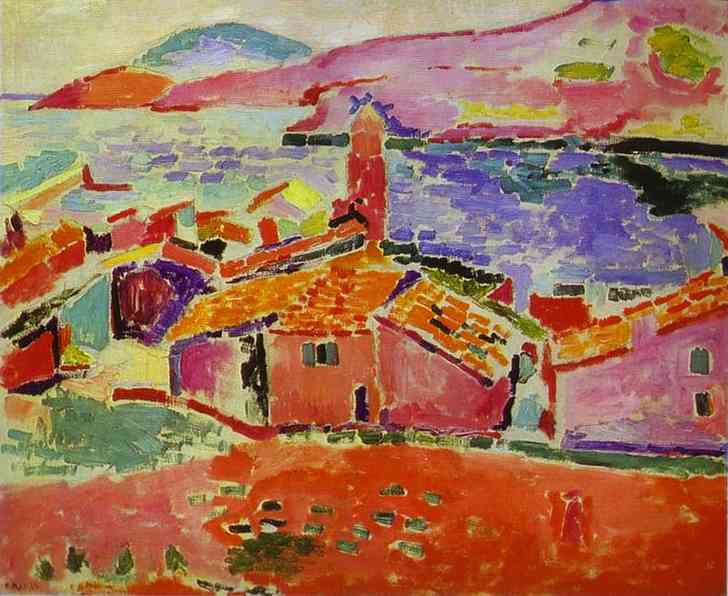
Cubism vs. Fauvism: Flat Appearance
Both Cubism and Fauvism reject traditional three-dimensional space and use flat areas of color to emphasize the subject matter. Cubist painters did not try to recreate three-dimensional space within their paintings, as demonstrated in Pablo Picasso’s Glass and Bottle of Suze, pictured below:
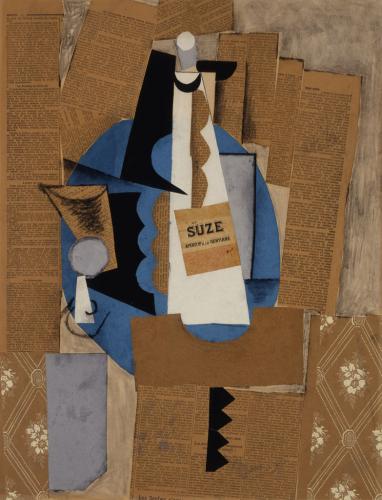
Fauvists also rejected this form of illusionistic image-making, which is why Fauvist paintings appear to be flat, much like a woodblock print.
Cubism vs. Fauvism: Inspiration
Cubism and Fauvism were inspired by Post-Impressionism, particularly by Paul Cézanne’s analytical approach to form and Paul Gauguin’s use of bold color combinations to express emotions. Cubist artists Pablo Picasso and Georges Braque conducted many artistic experiments using this analytical and deconstructive technique which led to the birth of the Cubism movement. Simultaneously, Henri Matisse and André Derain harnessed the painterly qualities and bright colors of post-Impressionism, along with the influence of Gustave Moreau, and exaggerated both to create unusually colorful landscapes and portraits.
Cubism and Fauvism Differences
Despite Fauvism’s influence on Cubism, Cubism is significantly different from Fauvism in many ways. The three main differences between Fauvism and Cubism are the Fauves’ use of unnatural color, their unnaturalistic and simplified subject matter, and lighthearted themes.
Cubism vs. Fauvism: Unnatural Color
For Fauvist artists, color was symbolic and played a vital role in expressing emotion. Fauvist painters often used saturated, unnatural colors. Fauvist painters paired complementary colors, like orange and blue, magenta and green, and purple and yellow, to create intense contrast between compositional elements. For instance, a Fauvist painting may feature a yellow sky, blue land, and orange figures with green background elements. Fauvist painters often applied bold paint hues directly from the paint tube without mixing.
Henri Matisse’s Woman with a Hat, pictured below, features unmixed colors in stark contrast, not typical of illusionistic portraits:
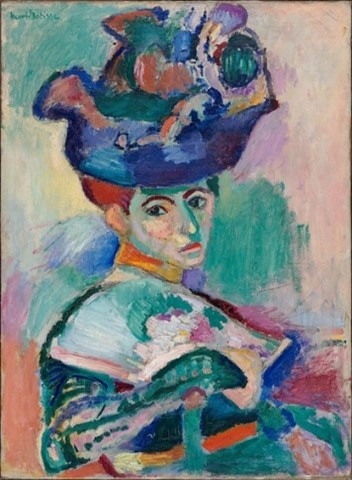
In contrast, many Cubist paintings feature a monochromatic color palette with mainly dark, earthy tones and many areas of shadow. Cubist artists often used a monochromatic scale to keep the viewer focused on their subject matter’s complex arrangement and geometric form. Emotion was not a primary consideration in the Cubist color palette.
Cubism vs. Fauvism: Simplified Subject Matter
Fauvists’ depiction of the subject matter sits in direct contrast to that of Cubism. Fauvist painters simplified their subject matter, sometimes to the point of appearing unnatural. Cubist painters depicted subjects so that their reconstruction, typically a compilation of dissected angles, made the subject look more complex and intricate than its original form.
Cubism vs. Fauvism: Lighthearted Themes
Fauvist paintings are primarily landscapes with figures engaged in leisurely activities. The carefree quality of Fauvist paintings reflects artists such as Henri Matisse’s desire to produce artwork that appealed to the viewer’s senses.
In The Joy of Life, pictured below, Henri Matisse depicts figures simply enjoying themselves in a landscape filled with lush greenery. However, in true Fauvist style, the greenery is mostly orange and red and the grass a bright yellow hue:
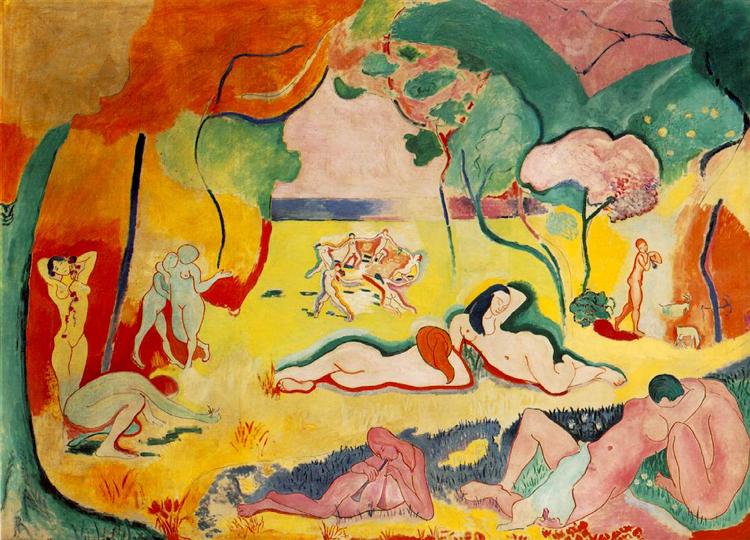
Cubist subject matter is often rigid and analytical, hence the name of the first significant phase of Cubism, Analytical Cubism. The viewer is often drawn to deciphering Cubism’s geometric planes as a portrait, still life, or landscape. However, the subject was not always the main focus of Cubist painting. Instead, the focus was on the ability to manipulate form.
How did Fauvism Influence Cubism?
Fauvism and Cubism occurred almost simultaneously in history and have similar origins and influences. Cubism was influenced by post-impressionist artists Paul Cézanne, Vincent van Gogh, and Paul Gauguin. The post-Impressionism art movement took a more analytical approach to painting landscapes, people, and objects and inspired many artists to embrace order and structure instead of emotional expression. Fauvism is mainly inspired by Paul Gauguin’s use of symbolic color to convey emotions and overlooks the analytical approach that became central to Cubism. Many Fauves later turned to Cubism, leaving behind boldly colored canvases for a more constrained color palette and a total reimagining of form.
What Are Other Art Movements Similar to Cubism and Fauvism?
Cubism and Fauvism are similar to German Expressionism, which emerged in Germany around the start of the 20th century and lasted from 1905-1920. Expressionist painting typically presents the world from a subjective perspective, radically distorting subject matter for an emotional effect and to evoke moods or ideas.
Cubism, Fauvism, and Expressionism art movement emerged in opposition to Realism and Naturalism and were inspired by the developments of post-impressionism. Compared to Cubism and Fauvism, Expressionism was also a relatively abstract painting style, though this varied between artists. For example, Vassily Kandinsky’s work is entirely abstract, whereas the work of Edvard Munch is representational.
The Cubist and Expressionist movements coexisted with numerous other art movements that emerged in the early 1900s. Much like Cubism, Expressionism was influenced by the Fauvist art movement, which explains Expressionism’s tendency toward jarring compositions and bright, complementary colors that convey an array of emotions.
Cubism, Fauvism, and Expressionism also explored similar themes in response to the effects of modernization and industrialization on society. Expressionists were most concerned with conflicts in human morality brought about by industrialization and the First World War, which sits in opposition to the leisurely themes expressed in Fauvist paintings.
